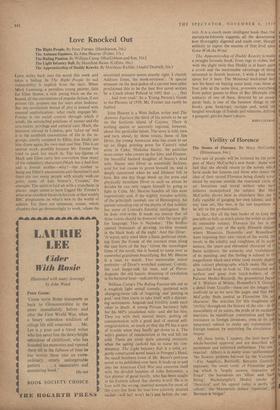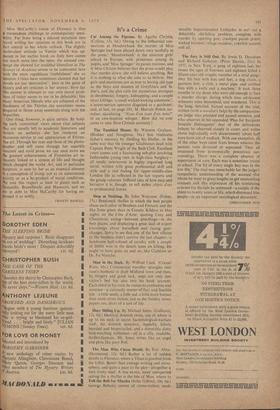Virility of Florence
By Mary McCarthy, t
The Stones of Florence. (Heinemann, 84s.)
Two sets of people will be irritated by the pros- pect of Mary McCarthy's new book : those who feel that she should return to the novels which have made her famous and those who resent the idea of their sacred Florence being closely scrut- inised by anyone outside the restricted circle of art historians and travel writers who have hitherto monopolised the subject. But Miss McCarthy shows here as elsewhere that she is fully capable of gauging her own talents; and ;11 any case art, like war, is far too important to be left to the professionals.
In fact, like all the best books of its kind this one tells us fully as much about the writer as about its ostensible subject. Florence for her is the gaunt, tough city of the early fifteenth century where Masaccio, Donatello and • Brunelleschi were imposing their new vision of the world. She revels in the solidity and roughness of its arch'' tecture, the spare and elemental character of its finest sculpture, the austerity and 'truthfulness of its painting; and this feeling is echoed in the magnificent black-and-white (and mostly deploy able colour) photographs which make this such a beautiful book to look at. The rusticated wall surface and great iron torch-holders of the Palazzo Medici-Riccardi, the geometrical facade of S. Miniato al Monte, Donatello's S. Giorgio, a detail from Uccello—these are the images that confront us as we turn the pages and that Miss McCarthy finds central to Florentine life and character. She searches for this toughness and `virility' throughout the history of the city--in the masculinity of its saints, the pride of its medi:ed warriors, its republican constitution and hero resistance to foreign invasions, even in its coo' temporary refusal to make any concessions t'1, foreign tourists by restricting the circulation yespas.
All these (even, I suspect, the last) have het whole-hearted approval and are described wit?' passionate and informed enthusiasm. The rest s rejected: Alberti is in many ways 'unFlorentine: `the flowery painters beloved by the Victorians —Fra Angelico, Botticelli, Benozzo Gozzoli represent 'the sweet tooth' of Florentine paint' ing which is 'largely austere, impassive .to61 frugal'; the humanists are 'effete' and `back biting'; M ichelangelo's Medici tombs are `theatrical' and his appeal today is partly ',4" colour'; the Mannerists induce 'repulsion'; the Baroque is 'vulgar.' Miss McCarthy's vision of Florence is thus tremendous challenge to contemporary sensi- lity. Far from being a relaxed excursion into tvel writing her opinions in this book are in ct central to her whole outlook. The slightly nbivalent attitude to Venice which was ap- Lrent in her earlier book on Italy here comes it much more into the open; the amused con- rnpt she showed for muddled liberalism in The roves of Academe seems to be contrasted here ih the stern republican 'truthfulness' she so !mires. Critics have sometimes claimed that her ■ vels are too 'destructive': here in the guise of story and art criticism is her answer. How far is answer is relevant to our own moral prob- -its of today seems to me to be debatable; like any'American liberals who are ashamed of the ushiness of the Thirties she sometimes seems epared to throw away essentials along with the 'purities.
One thing, however, is quite certain. By hold- s such 'committed' views about vital subjects at are usually left to academic historians and -iters on aesthetics she has rendered an ormous service to our appreciation of Floren- le art. Through her eyes and those of the photo- tpher and still more through her superbly ncrete and vivid prose we can once more see a greatest achievements of Florentine art in- nately linked to a system of life and thought rich changed the world. Art, and in particular ilpture, is seen by her as an essential element a conception of living: not as an autonomous tivity or as a by-product of social conditions. e owe this respect at least to giants such as matello, Brunelleschi and Masaccio, and we
FRANCIS HASKELL







































 Previous page
Previous page